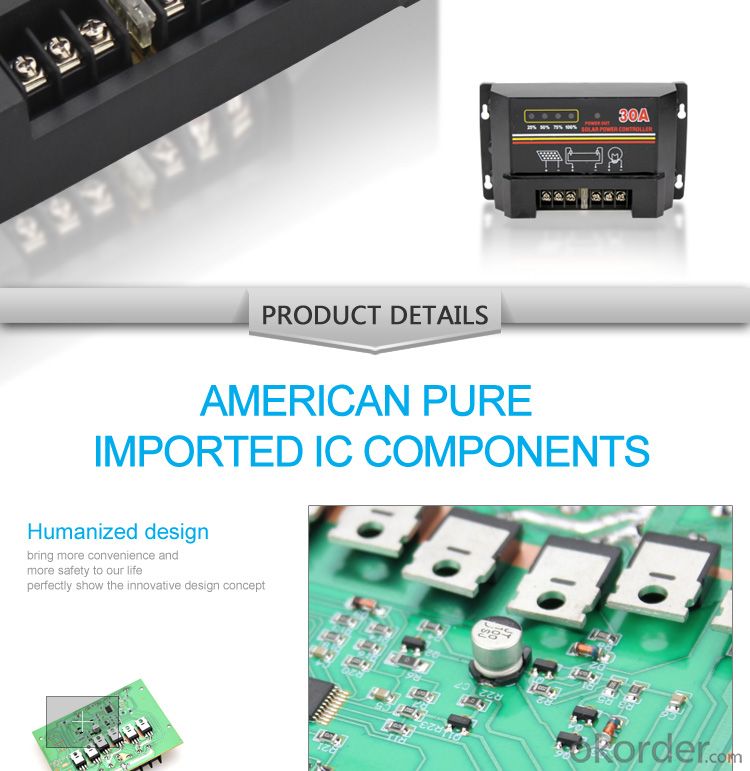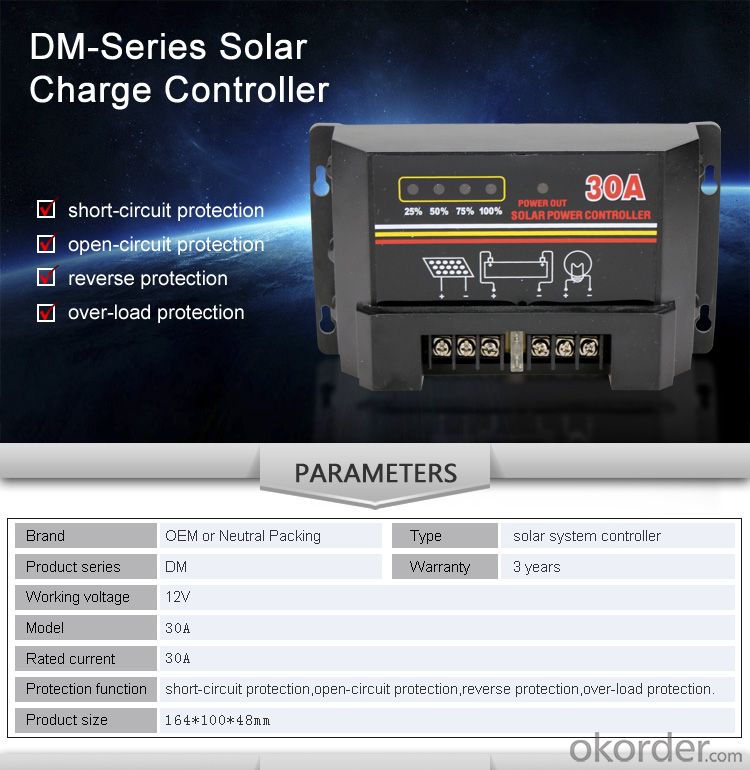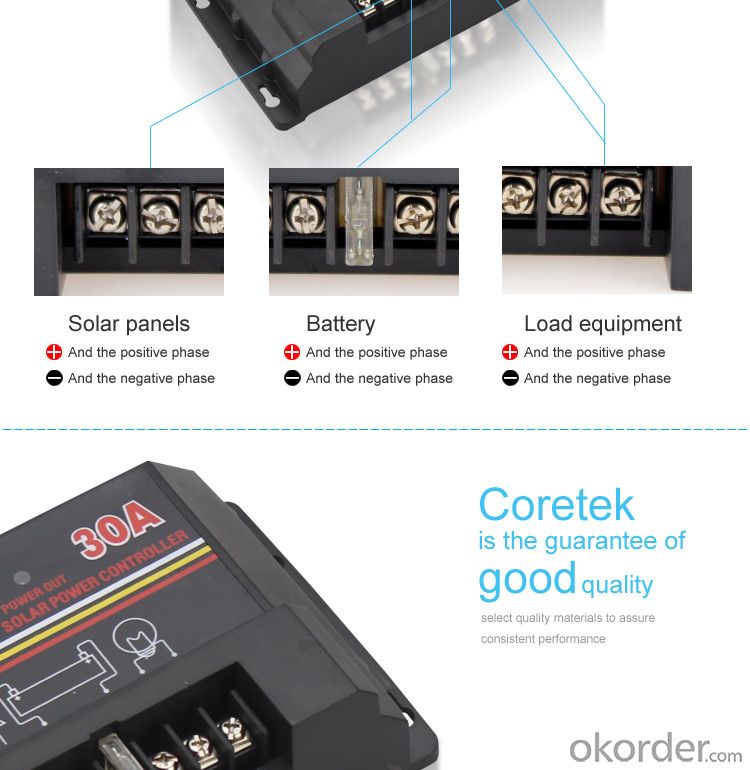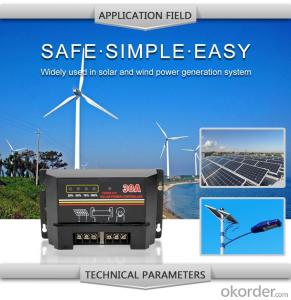Solar LCD Controller with Best Price Hot Selling Model DM130A
- Loading Port:
- China main port
- Payment Terms:
- TT or LC
- Min Order Qty:
- 1 unit
- Supply Capability:
- 10000 unit/month
OKorder Service Pledge
OKorder Financial Service
You Might Also Like
Product IntroductionSolar controller is control device which can control solar panel and transform solar energy into electricity then store to the battery bank. Solar controller is the most important part in offgrid system, whose performance has much effect on life expectancy and operation of the whole system, especially the battery expectancy.
Application Areas
Standalone Photovoltaic power station
Standalone Domestic household photovoltaic power system
Mobil communication base stations, expressway and other non-residential regions.
Coastal islands, remote mountainous, border posts for regions shortage of or without electricity.
Government demonstration projects, landscape lighting project etc.




- Q:How does a solar controller handle short circuit protection?
- A solar controller handles short circuit protection by automatically detecting and disconnecting the circuit in case of a short circuit. This is done through the use of built-in circuit breakers or fuses that trip or blow when a short circuit occurs, preventing any damage to the solar panels or the controller itself.
- Q:Can a solar controller be used with a portable solar panel?
- Certainly, a portable solar panel can indeed be paired with a solar controller. The primary function of a solar controller is to oversee the charging process of a solar panel and safeguard the battery against overcharging. Serving as an intermediary between the solar panel and the battery, it guarantees the battery's receipt of an optimal charge level. Irrespective of whether the solar panel is portable or stationary, utilizing a solar controller enables the battery to achieve peak efficiency and prolong its lifespan.
- Q:How does a solar controller prevent overvoltage damage to batteries?
- A solar controller prevents overvoltage damage to batteries by regulating the amount of voltage and current being supplied to the batteries from the solar panels. It continuously monitors the battery voltage and disconnects the charging source when the battery reaches its maximum voltage level, protecting it from overcharging and potential damage.
- Q:Can a solar controller be used with different types of solar charge controllers?
- No, a solar controller is specifically designed to work with a specific type of solar charge controller and may not be compatible with different types.
- Q:How does a solar controller handle different charging stages?
- A solar controller manages different charging stages by regulating the flow of electricity from the solar panels to the battery. It monitors the voltage and current levels to ensure efficient charging and prevent overcharging. During bulk charging, the controller allows maximum current flow to quickly recharge the battery. In the absorption stage, the controller gradually reduces the charging current to avoid overcharging and sustain the battery capacity. Finally, in the float stage, the controller maintains a lower voltage to keep the battery at a fully charged state without causing any damage.
- Q:How does a solar controller handle high voltage spikes or surges?
- A few different methods are employed by a solar controller to handle high voltage spikes or surges. To begin with, most solar controllers are equipped with built-in overvoltage protection. This means they can endure higher voltages than their rated capacity without sustaining damage. This protective feature safeguards the controller against voltage spikes that may occur during thunderstorms or other electrical disruptions. Furthermore, solar controllers often utilize surge protection devices, such as varistors or transient voltage suppressors. These devices are designed to redirect excessive voltage away from the controller, preventing it from being overwhelmed by sudden surges. Moreover, certain solar controllers incorporate voltage clamping circuits that restrict the voltage to a safe level. These circuits serve as a safety measure by ensuring that the voltage does not exceed a specific threshold, even in the event of a spike or surge. In conclusion, the combination of overvoltage protection, surge protection devices, and voltage clamping circuits enables a solar controller to effectively manage high voltage spikes or surges. By absorbing, redirecting, or limiting the excess voltage, the solar controller ensures the safety and durability of the connected system.
- Q:Can a solar controller be used with solar-powered gates?
- Yes, a solar controller can be used with solar-powered gates. A solar controller is an essential component of a solar power system as it regulates the flow of electricity from the solar panels to the gates. It ensures that the energy generated by the solar panels is efficiently utilized and stored in the batteries, which then powers the gates. The solar controller also manages the charging process and protects the batteries from overcharging or discharging, thus prolonging their lifespan. Therefore, a solar controller is necessary for the proper functioning and optimal performance of solar-powered gates.
- Q:How does a solar controller handle battery capacity testing?
- A solar controller handles battery capacity testing by monitoring the voltage and current of the battery during the charging and discharging process. It uses this data to calculate the state of charge (SOC) of the battery, which indicates the remaining capacity. The solar controller may also use algorithms to estimate the battery capacity based on its performance over time.
- Q:What is the maximum power capacity that a solar controller can handle?
- The specific model and manufacturer determine the maximum power capacity that a solar controller can handle. Solar controllers have the task of regulating the power flow from solar panels to batteries or other loads. They are typically rated in terms of their maximum current handling capacity, which is measured in amps. To calculate the maximum power capacity of a solar controller, multiply the maximum current rating (in amps) by the system voltage (in volts). For instance, if a solar controller has a maximum current rating of 30 amps and the system voltage is 12 volts, the maximum power capacity would be 360 watts (30 amps x 12 volts = 360 watts). It is crucial to select a solar controller that can handle the maximum power capacity of your solar system. Going beyond the maximum power capacity of a solar controller can result in overheating, reduced efficiency, or even damage to the controller. For this reason, it is advisable to refer to the manufacturer's specifications or seek professional advice to ensure that the solar controller is suitable for the power capacity of your specific solar system.
- Q:Can a solar controller be used with a solar-powered military base?
- Yes, a solar controller can be used with a solar-powered military base. A solar controller is an essential component in a solar power system as it regulates the flow of electricity from the solar panels to the batteries, ensuring efficient charging and preventing overcharging or damage. In a solar-powered military base, a solar controller would be necessary to manage the energy production and storage, helping to optimize the use of solar power and ensure reliable and sustainable energy supply for the base's operations.
1. Manufacturer Overview |
|
|---|---|
| Location | |
| Year Established | |
| Annual Output Value | |
| Main Markets | |
| Company Certifications | |
2. Manufacturer Certificates |
|
|---|---|
| a) Certification Name | |
| Range | |
| Reference | |
| Validity Period | |
3. Manufacturer Capability |
|
|---|---|
| a)Trade Capacity | |
| Nearest Port | |
| Export Percentage | |
| No.of Employees in Trade Department | |
| Language Spoken: | |
| b)Factory Information | |
| Factory Size: | |
| No. of Production Lines | |
| Contract Manufacturing | |
| Product Price Range | |
Send your message to us
Solar LCD Controller with Best Price Hot Selling Model DM130A
- Loading Port:
- China main port
- Payment Terms:
- TT or LC
- Min Order Qty:
- 1 unit
- Supply Capability:
- 10000 unit/month
OKorder Service Pledge
OKorder Financial Service
Similar products
New products
Hot products
Hot Searches
Related keywords































